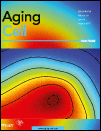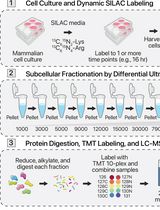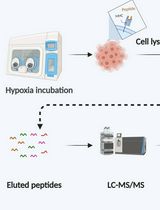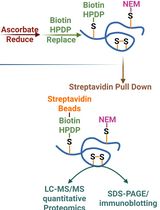- EN - English
- CN - 中文
Biochemical Isolation of Myonuclei from Mouse Skeletal Muscle Tissue
从小鼠骨骼肌组织中骨骼肌细胞核的生化分离
发布: 2017年12月20日第7卷第24期 DOI: 10.21769/BioProtoc.2654 浏览次数: 12966
评审: Nicoletta CordaniAntoine de MorreeYann Simon Gallot
Abstract
Skeletal muscle provides the contractile force necessary for movement, swallowing, and breathing and, consequently, is necessary for survival. Skeletal muscle cells are unique in that they are extremely large cells containing thousands of nuclei. These nuclei must all work in concert to maintain skeletal muscle function and thereby maintain life. The nucleus is a major site of signaling integration and gene expression regulation. However, examining nuclear processes in skeletal muscle can be difficult because myonuclei are challenging to isolate. We optimized a protocol to purify myonuclei from whole muscle tissue using ultracentrifugation over a discontinuous sucrose gradient to separate the nuclear fraction. We used these purified nuclei for downstream applications including flow cytometry and mass spectrometry. We used this method to compare the myonuclear proteome of young and old mouse hindlimb muscles (Cutler et al., 2017). This protocol may be applied to isolating myonuclei for a variety of downstream analyses such as flow cytometry, microscopy, Western blot, and proteomics.
Keywords: Fractionation (分馏)Background
Proper skeletal muscle function must be maintained for survival. One component of this maintenance is adjustments in gene expression in response to cellular needs and environmental cues. Nuclear processes modulating gene expression are a critical component in regulating cellular composition and behavior. However, myonuclear proteins involved in these processes are difficult to study because of four technical limitations. First, skeletal muscle is dense, tightly packed with contractile proteins that make up more than 60% of proteins in the tissue (Deshmukh et al., 2015; Cutler et al., 2017). These high abundance contractile proteins eclipse the far less abundant nuclear proteins. Second, the dense fibrous structure of skeletal muscle makes it difficult to dissociate without damaging nuclei, making nuclei difficult to isolate. Third, after centrifugation dense debris cosediments with nuclei, compounding the difficulty of isolating nuclei from the tissue. Fourth, skeletal muscle is comprised of multiple cell types, so nuclei isolated and nuclear proteins detected may be from myonuclei or nuclei of other cell types.
Several approaches have been optimized to enrich myonuclei from different organisms for various downstream applications. Ohkawa et al. presented a detailed protocol for isolating myonuclei from mouse tissue that was developed to maximize access of cross-linking reagent for Chromatin Immunoprecipitation (ChIP) analysis (Ohkawa et al., 2012). Wilkie and Shrimer developed a procedure to isolate the myonuclear envelope and sarcoplasmic reticulum for proteomic comparison (Wilkie and Schirmer, 2008). An approach optimized by Dimauro et al. simultaneously collected mitochondrial, nuclear, and cytoplasmic fractions to compare protein localization among different cellular compartments (Dimauro et al., 2012). While each of these approaches to enrich nuclei from skeletal muscle tissue was effective for the intended subsequent analysis, they did not prioritize isolating intact nuclei and not distinguish between myonuclei and nuclei from other cell types. An affinity-based method to selectively isolate nuclei from specific cell types was developed in Arabidopsis thaliana (Deal and Henikoff, 2011) and is now available for mice (Jankowska et al., 2016). However, this affinity-based approach requires genetic labeling of the cell types of interest, which makes it prohibitively cumbersome to examine myonuclei from multiple mouse models. We optimized an ultracentrifugation sucrose gradient-based fractionation approach that requires relatively small sample sizes, no genetic labeling, and is compatible with downstream analysis by flow cytometry and mass spectrometry. The isolated nuclei are intact, biochemically depleted of proteins from non-nuclear organelles, and 85% of nuclei are myonuclei. To isolate myonuclei more quickly we also optimized affinity-based purification using a myonuclear-specific nuclear envelope protein, Transmembrane Protein 38A (TMEM38A) (Bleunven et al., 2008; Cutler et al., 2017), and magnetic beads. This approach is more rapid and yields nuclei with comparable population purity to nuclear isolation by ultracentrifugation but with lower biochemical purity. These nuclear isolation techniques can be used to purify myonuclei from any mouse model for diverse downstream analyses.
Materials and Reagents
- Materials
- 30 ml ultraclear ultracentrifuge tubes (Beckman Coulter, catalog number: 344058 )
- 10 ml round bottom polypropylene tubes (Corning, Falcon®, catalog number: 352059 )
- 40 µm nylon mesh cell strainer (Biologix, catalog number: 15-1040 )
- 50 ml conical polypropylene tubes (BioExpress, catalog number: C-3394-4 )
- 15 cm glass Pasteur pipets (Fisher Scientific, catalog number: 13-678-20A )
- 20-gauge needle (Fisher Scientific, catalog number: 14-826-5C)
Manufacturer: BD, catalog number: 305176 . - 10 ml syringe (BD, catalog number: 309604 )
- 1.7 ml low-adhesion hydrophobic tubes (BioExpress, GeneMate, catalog number: C-3302-1 )
- 5 ml conical polystyrene tube with cell strainer cap (Corning, catalog number: 352235 )
- 0.45 µm polypropylene syringe filters (Thermo Fisher Scientific, Thermo ScientificTM, catalog number: F2500-9 )
- 30 ml ultraclear ultracentrifuge tubes (Beckman Coulter, catalog number: 344058 )
- Reagents
- Ethanol
- 4,6-Diamidino-2-phenylindole (DAPI) (Sigma-Aldrich, catalog number: D9542 )
- Protein A-conjugated magnetic beads (Thermo Fisher Scientific, InvitrogenTM, catalog number: 10001D )
- Anti-TMEM38A antibody (Merck, catalog number: 06-1005 )
- Ethylenediaminetetraacetic acid (EDTA) (Fisher Scientific, catalog number: BP120 )
- Sodium hydroxide (NaOH) (Fisher Scientific, catalog number: S318 )
- Ethylene glycol-bis(β-aminoethylether)-N,N,N’,N’-tetraacetic acid (EGTA) (Sigma-Aldrich, catalog number: E3889 )
- Sucrose (Fisher Scientific, catalog number: BP220 )
- HEPES (Fisher Scientific, catalog number: BP310 )
- Potassium chloride (KCl) (Fisher Scientific, catalog number: P217 )
- Magnesium chloride hexahydrate (MgCl2·6H2O) (Fisher Scientific, catalog number: M33 )
- Spermidine (Sigma-Aldrich, catalog number: 85558 )
- Dithiothreitol (DTT) (United States Biological, catalog number: D8070 )
- cOmplete mini protease inhibitors (Roche Diagnostic, catalog number: 11836153001 )
- Bovine serum albumin (BSA) (Sigma-Aldrich, catalog number: A2153 )
- Spermine tetrahydrochloride (Sigma-Aldrich, catalog number: S2876 )
- 1x phosphate buffered saline (Thermo Fisher Scientific, GibcoTM, catalog number: 21600069 )
- 100 mM EDTA (see Recipes)
- 100 mM EGTA (see Recipes)
- 2.1 M sucrose solution (see Recipes)
- 2.8 M sucrose solution (see Recipes)
- Homogenization buffer (see Recipes)
- 1% BSA homogenization buffer (see Recipes)
- Resuspension buffer (see Recipes)
- 1% BSA resuspension buffer (see Recipes)
Equipment
- Dissection equipment
- 15 ml Dounce homogenizer with PTFE serrated plunger (Cole-Parmer Instrument, catalog numbers: 44468-10 and 44468-16 )
- UV lamp (optional) (Spectroline, catalog number: ENF-240C )
- Centrifuge (Eppendorf, model: 5702 )
- Microcentrifuge (International Equipment Company, model: S139068 )
Note: This product has been discontinued. - Ultracentrifuge (Beckman Coulter, model: OptimaTM LE-80K , LLE7)
- SW 32 Ti swing bucket rotor (Beckman Coulter, model: SW 32 Ti , catalog number: 369650)
- UltraRocker rocking platform (Bio-Rad Laboratories, catalog number: 1660709EDU )
- Magnet (optional) (Thermo Fisher Scientific, catalog number: 12320D )
- Round ended microspatula (Fisher Scientific, catalog number: 21-401-5 )
Procedure
文章信息
版权信息
© 2017 The Authors; exclusive licensee Bio-protocol LLC.
如何引用
Cutler, A. A., Corbett, A. H. and Pavlath, G. K. (2017). Biochemical Isolation of Myonuclei from Mouse Skeletal Muscle Tissue. Bio-protocol 7(24): e2654. DOI: 10.21769/BioProtoc.2654.
分类
细胞生物学 > 细胞器分离 > 微核
发育生物学 > 细胞生长和命运决定 > 肌纤维
生物化学 > 蛋白质 > 定量
您对这篇实验方法有问题吗?
在此处发布您的问题,我们将邀请本文作者来回答。同时,我们会将您的问题发布到Bio-protocol Exchange,以便寻求社区成员的帮助。
Share
Bluesky
X
Copy link














